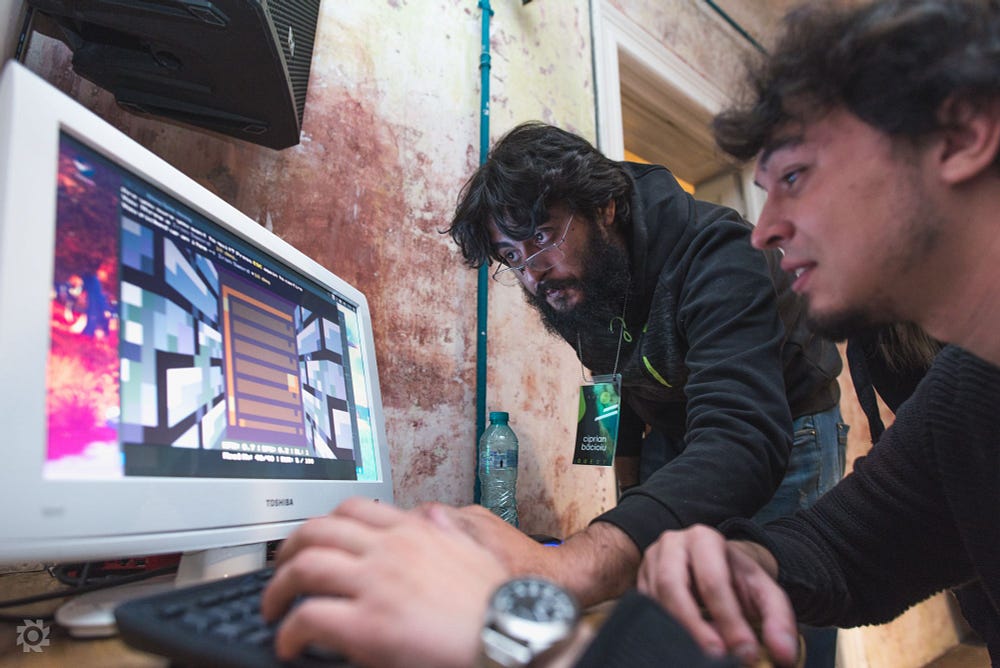Trending
Opinion: How will Project 2025 impact game developers?
The Heritage Foundation's manifesto for the possible next administration could do great harm to many, including large portions of the game development community.

Featured Blog | This community-written post highlights the best of what the game industry has to offer. Read more like it on the Game Developer Blogs or learn how to Submit Your Own Blog Post
This post covers what I learned after demoing a game that did not offer conventional keyboard controls. 40% of my players never made it past the main menu because the controls were not standard.

This weekend I traveled to Clujotronic — an arts and entertainment event — in Cluj, Romania, where I demoed my new game: Ebony Spire: Heresy. The audience of the event had very little in common with my target audience for the game but I learned a whole lot of from the people who tried the demo. Let’s take a look what people who never tried a old school RPG with un-conventional button mappings had to say.

Showing the game to a fellow designer who did not understand how to open doors.
The audience at Clujotronic was mostly young people in their 20’s. Most of them electronic fans with a taste for artsy stuff. A few of them were actual gamers of the mainstream kind (think AAA games). Most games featured at the venue (like Black the Fall, Second Hand: Frankie’s Revenge, Raiders of the Lost Island) were Indie games and it was great seeing people interacting with them for the first time. They all featured controller support and most players had little problems figuring out what to do. In my case there was only a screen and a keyboard and, for a few hours after setting up my “booth”, a mouse.
My target audience are technical, slightly older gamers who enjoyed dungeon crawling classics like Eye of the Beholder or Dungeon Master or fans of the roguelike genre that are looking for a more graphical game in the vein of the previously mentioned titles. The game relies heavily on the keyboard and breaks the conventional streamlined controls. I promised myself I won’t intervene and describe the game’s control to players until they all but gave up on trying. A good way to get data and see how much time they are willing to sacrifice before giving up.
What I noticed is that in the absence of a controller, when faced with a unfamiliar games, the first thing people gravitate towards is the mouse and arrow keys. If the game does not respond to those two types of inputs well… let’s just say that 70% of the people who tried the game gave up, assumed it froze/crashed and just left it at that. The remaining 30% are split between randomly pressing keys until something happens, checking out the monitor to see if it’s touch enabled (it wasn’t) or, those more interested in experiencing it, asking people around them for information. Touch screen-ers were more common than those willing to ask for information

First batch of players pre-key update
So after a few hours of me staring at people’s fingers gravitating towards the arrow keys I was faced with two decisions:
The easy way out: Print the controls on paper and stick it to the side of the screen
The slightly less harder way: Add support for the Arrow Keys and the Enter button.
I wanted as much data as I could get from the players and I didn’t feel like cheating and sticking a piece of paper in their face so I added support for the aformentioned keys in the Menu’s and the retention rate grew. I also hid the mouse from view.

Now that the “standard” way of navigating through the in-game menus was solved I almost had a full 100% retention rate until gameplay started (A few gave up once they entered the help menu and saw a wall of text). The first big hitch was met when the game started and arrow keys were once again useless. Here things took a weird turn.

Most players (a bit over 50%) went straight for W,A,S and D controls once the arrow keys were deemed useless. Twelve people asked if the mouse is missing. Around 25% of them moved on without wanting to hear any explanation about the controls. Slightly less than that asked for help immediately after the arrow keys failed to do anything.
Once they figured out you can move around with WASD and turn the camera with Q+E they started exploring the first level. After experiencing the grid-based movement a few of them asked if the game was turn based. Spotting the first NPC made them want to grab a mouse out of instinct to shoot. This was a big amount of players (sadly I did not record this data). Others moved next to him and asked how to engage and attack. But the controls did not click with them until two more buttons were revealed: “I” to access the Inventory and “T” to throw items at the enemies. Quite a few of them questioned the decision to interact with the environment (here doors) by using the “O” key. They expected to press E or F. But as soon as they found their first items on the floor, and thinking about the previous keybindings it all clicked. More than once I heard: “How do I pick up an item.. Wait? Is IT P? Oh it is P! I GET IT NOW”. And then, suddenly, O to open doors, I to open the inventory, T to throw, P to pickup, L to access the log suddenly made sense for them. And after playing the game and noticing other people trying to figure it out they chimed in and helped excitedly. It even became a running gag around the venue. When people would ask if the bathroom is occupied some would answer: “Press O to open and see for yourself” or the now classic at the bar: “Should I press B for beer?”.
People figuring out the controls and being excited for the discovery was a great thing to witness however there’s a problem here hiding in plain sight: out of all progress data I recorded while the game was demoed the following things stand out:
Less than 3% of the total players reached the final (3rd) level of the demo
Only 15% explored the first level and its two portals
A whooping 40% of all people that tried the game gave up at the main menu
I cannot stress the last part enough: Because the default input method WAS NOT the norm almost half of the people who tried the game never even got to the game part. Imagine this data wasn’t picked up during the demo and I would have only found out about it after doing the steam release. A 40% refund rate would have killed me, my game and my business. Now I can argue that the drop rate would have been lower because of my target audience and their experience, because people that invest money in the game would stick around more and learn how to play it but it would still have dented my income and review scores.
The amount of polish before I launch next month is huge. I need to get a tutorial system in the game. Or a better way to present the controls. I am sticking to them but I learned that learning them through pure discovery, even if rewarding, can potentially put people off. People who are to be my customers and supporters.
I also learned that players who expect a mouse and do not find it will touch, press and even shake a regular monitor. Even when there is someone nearby to explain the game to them.

Ebony Spire: Heresy was demoed at Clujotronic. It’s a first person, dungeon crawling, turn based rpg inspired by roguelikes. The main mechanic revolves around picking up items and using them against your enemies. And the enemies can do the same things you can do. And you need to press “O” to open doors. It will release on steam in November. You can pick-up and play the Clujotronic 3 level demo for Linux and Windows from itch.io. And even buy the game at half-the-release price if you want to throw mean words about the controls at me.
You May Also Like